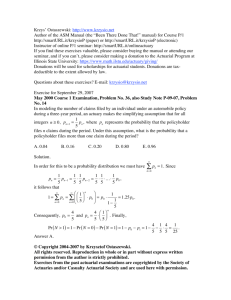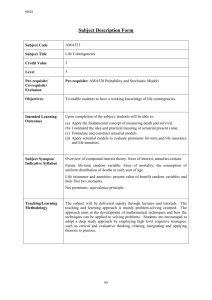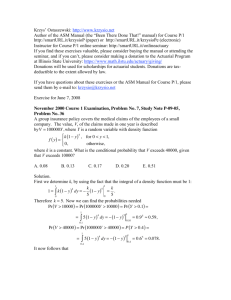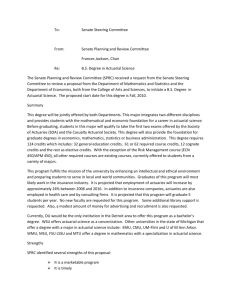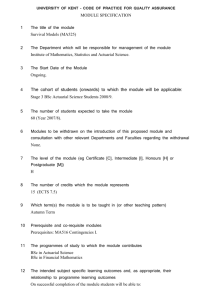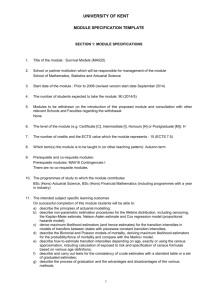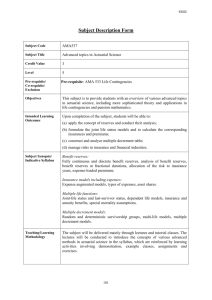Challenges for Risk Management of Life-Insurers
advertisement
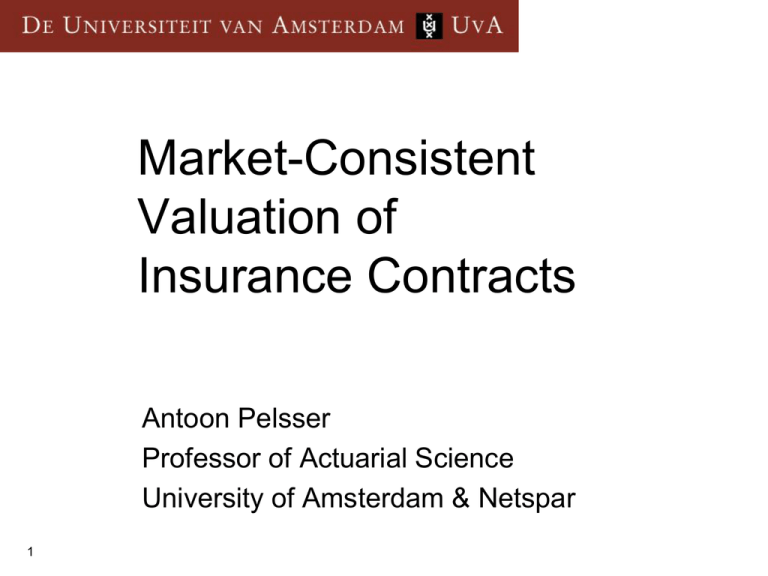
Market-Consistent Valuation of Insurance Contracts Antoon Pelsser Professor of Actuarial Science University of Amsterdam & Netspar 1 Outline Historical Roots: Actuarial & Finance Collapse of Equitable Life Market-Consistent Valuation New Directions for Actuaries 2 Historical Roots: Actuarial Life-insurance is “oldest profession” 1670’s: Valuation of Annuities Complex calculations long before computer-age Deal with uncertainty via conservative deterministic assumptions 3 Actuarial education more “art” than “science” Create extra buffers as a “cushion” for risk Historical Roots: Actuarial (2) First half of 20th century Investment portfolio of life-insurers mainly bonds Investment returns higher than base-rate Risk-sharing between insurer and policyholder 4 Prudence to cover for “actuarial” risks “With-profits” insurance policies Historical Roots: Actuarial (3) Last quarter of 20th century Invest (aggressively) in stocks Continue to use traditional actuarial methods 5 Higher return than bonds “Unit-Linked” insurance products “Prudent” base rate Profit-sharing Minimum return guarantees Historical Roots: Finance “Meanwhile in banking…” 1950: Markowitz 1970: Black-Scholes-Merton 6 Derivative pricing via “Delta-Hedging” Completely different methodology of dealing with risk! Mean-Variance optimisation Reduce risk via offsetting trading-positions 1980+: Development of risk-management and supervision in banking Collapse of Equitable Life End of 1990’s: Collapse of Equitable Life in UK Guaranteed Annuity Option (GAO) 7 Oldest life-insurance company (1762) Large life-insurance company Mortality Guarantee (1950’s table) Interest Rate Guarantee (8%) Significant change in both risk-factors from 1970 – 1999 Wake-Up Call for Actuaries Shock for actuaries as “risk professionals” Severe criticism in UK on the profession Morris Review of the Actuarial Profession Market risks are often larger than insurance risks Regulators push for Market-Consistent Valuation 8 Denmark, Switzerland, UK, Netherlands Europe → Solvency II IASB → Accounting of Insurance Contracts Market-Consistent Valuation MC value of Liabilities = Market value of Replicating Portfolio Discount cash flows with today’s term structure of interest rates Calculate value of embedded options with arbitragefree pricing “Risk-neutral” pricing 9 Different from “classical” Embedded Value New Directions for Actuaries Bring “classical” actuaries up-to-speed with “modern” financial economics Important steps have already been made Continuing improvement in the curriculum needed Change from “risk observer” to “risk manager” “Reserve for the risk & wait”… Change in attitude is not easy Use active risk management (for financial risks) 10 New Directions… (2) European Insurance Regulators are developing Solvency II, which is fully market-consistent based How to deal with Internal Models? New proposal from IASB is fully consistent with market-consistent principles No consensus (yet) on how to calculate “the” Market-Consistent value: 11 Own Credit Rating Market Value Margin New Directions… (3) “Financial-economic” pricing assumes “complete market” Every insurance contract can be replicated by financial instruments This is not true for insurance! Pricing rules in “incomplete” markets Mortality risk & trends Insurance risks (Irrational) Policyholder behaviour “With-Profits” contracts 12 New Directions… (4) Find pricing rules that are Consistent with arbitrage-free pricing for financial risks Extend for non-financial risks Utility-based approach seems promising Find practical “rules-of-thumb” 13 This is currently a field of active academic research (€1 mln grant from Netspar)
